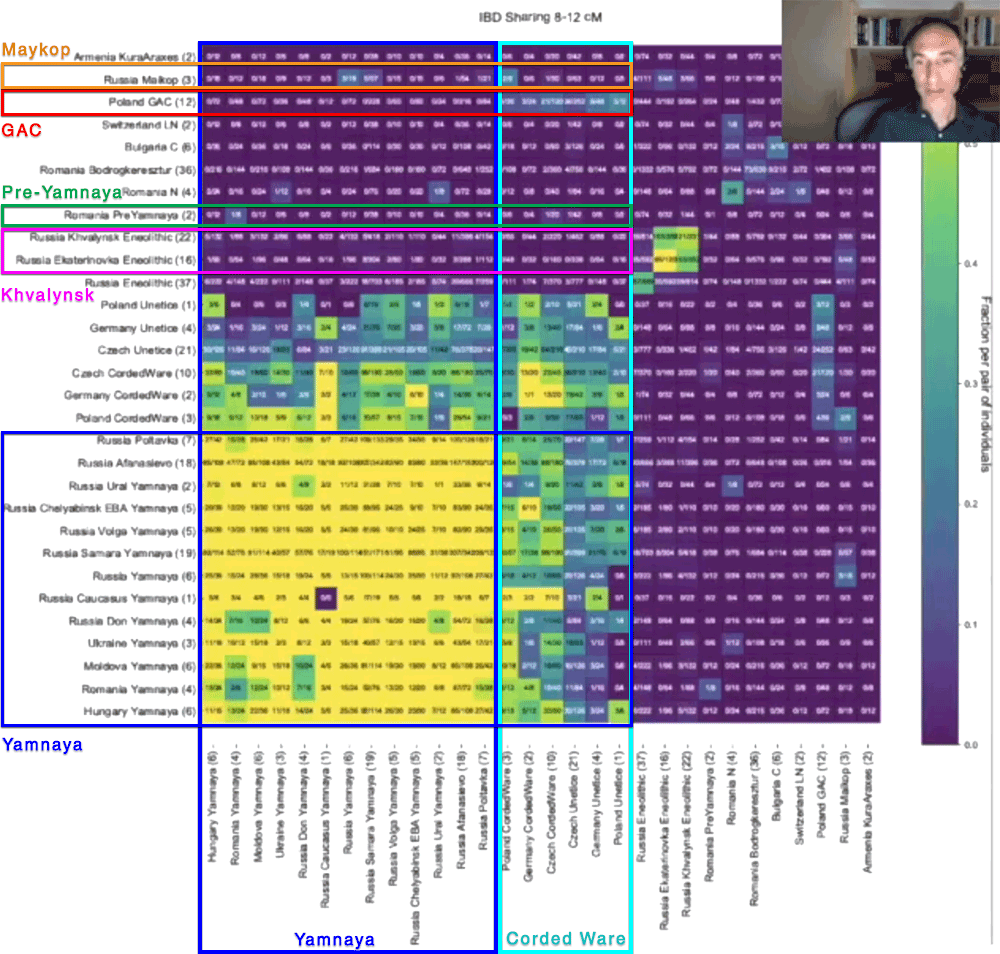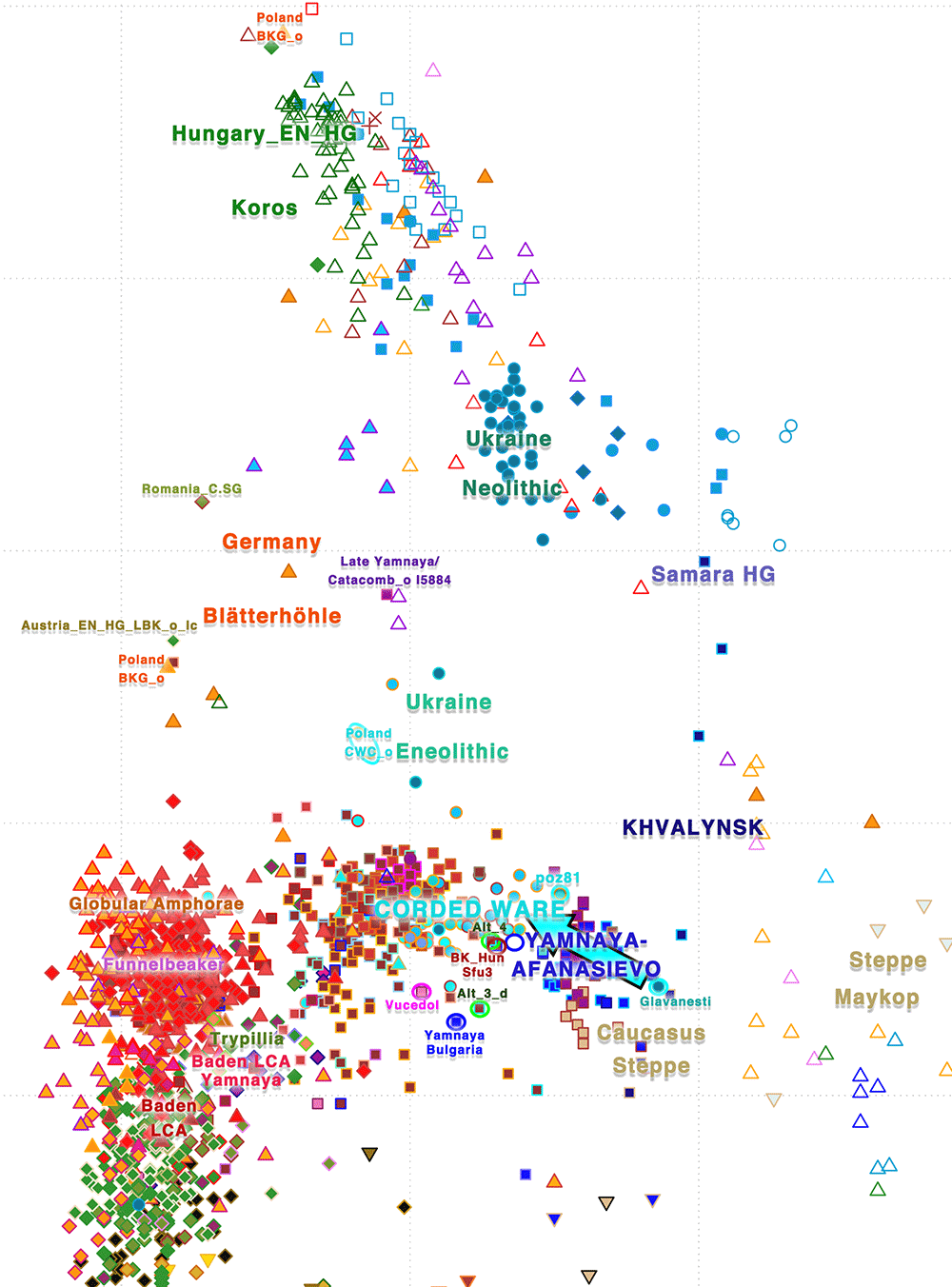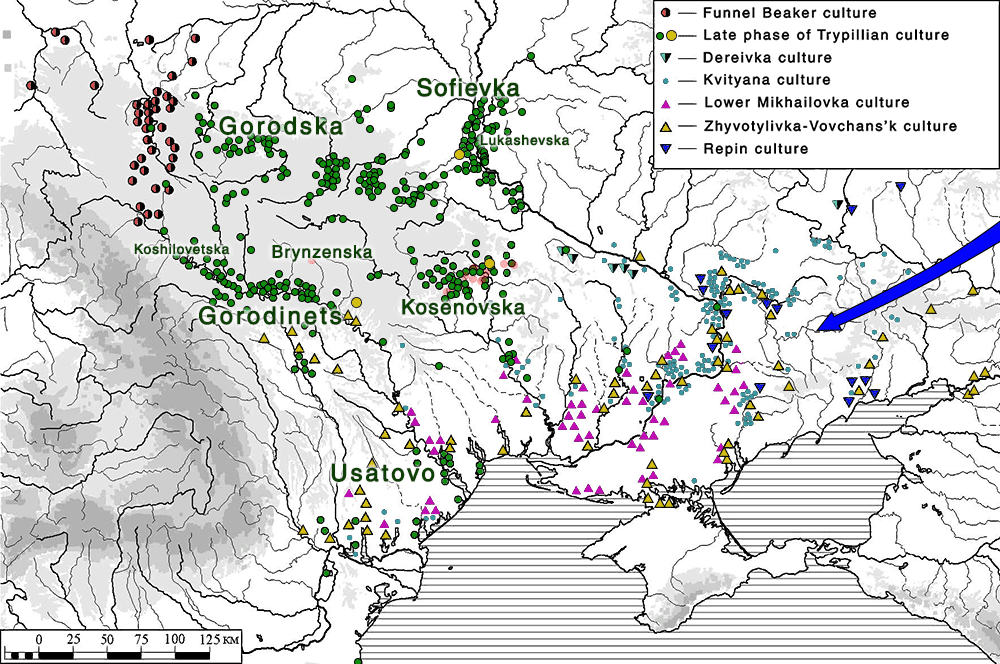Oral communication Ancient DNA and the New Science of the Human Past by David Reich (March 3, 2021).
I noticed this interesting slide called “Caught red-handed”, at approximately 45m 17s, where David Reich asserts that sampled Corded Ware populations had many “close cousins” with Yamnaya-related populations “within generations”. The method could also be used, always according to Reich, to identify “who the Yamnaya mixed with to form groups like Corded Ware”.
NOTE. Notice also the the number of new sampled individuals from Khvalynsk, Ekaterinovka, and new Yamnaya groups from Chelyabinsk, Urals, Volga, Don, Moldova, and Romania.

This represents the application of the method described by Ringbauer, Novembre & Steinrücken bioRxiv (2020), useful to detect runs of homozygosity longer than 4 centimorgan for ancient individuals with at least 0.3x coverage.
While applying the method to steppe-related populations for purposes of detecting fine-scale population structure seems promising, there are some problems at first sight based on the simplistic interpretations done by David Reich (even without being able to read the full analyses yet):
1. There has been no testing of this method for other modern or ancient populations with a known genetic and cultural history, which limits the applicability and interpretation for Steppe-related ones. We already have MLBA populations from the steppes showing quite big chunks of shared ROH despite being a priori unrelated, except with populations that existed centuries before.
NOTE. David Reich talks about the advantages and shortcomings of an application of Identity-by-Descent analysis like that of 23andMe to ancient populations at the end of the talk.
2. Khvalynsk and Ekaterinovka show little to no IBD sharing with Yamnaya- and Afanasievo-related populations, despite being the most likely source of Late Repin, itself the immediate origin of Yamnaya and Afanasievo and therefore of the spread of hg. R1b-L23, the paradigmatic lineage that spread with Proto-Indo-Europeans. Further, Yamnaya-related groups show no IBD sharing with other sampled neighbouring Eneolithic groups from west to east.
3. The closest direct ancestors of R1a-rich Corded Ware populations available to date are Late Trypillians, like the reported sample from Glăvănești (ca. 3500-3000 BC), of hg. R1a-Z93* and full Steppe-like ancestry. Despite this direct connection, Corded Ware groups show little to no IBD sharing with the so-called Romania Pre-Yamnaya samples investigated.

4. GAC shows no IBD sharing with Yamnaya, which looks rather odd, if it formed (at least part of) the Anatolia Neolithic-like ancestry present in (at least some western) Yamnaya settlers roughly coeval with early Corded Ware groups. Also, no comparison is shown with Trypillia, which preceded GAC and Yamnaya in Ukraine, and might be the origin of a good part of those shared cM among groups.
5. In particular, and trying to put a meaningful threshold for potential recent relatedness – judging by the color patterns of the much later, unrelated Únětice samples – Corded Ware groups show only a promising common closer relationship with 1 Yamnaya sample from the Caucasus, which is even more difficult to explain from a cultural point of view, except perhaps by their common relationship to Steppe Maykop (which would be supported by the supposed “close cousins” of Poland Corded Ware with Maykop).
EDIT (3/6/2021) In a previous revision, I noted that this Yamnaya individual from the Caucasus showed no “close cousins” with itself, which seemed odd, but another single sample representing Poland Únětice also shows no IBD sharing with itself, which suggests that the method appropriately excludes self-references.
Furthermore, all Yamnaya-related populations show a surprisingly homogeneous high number of shared segments between populations distributed (ca. 3100-2600 BC) over thousands of km, from Hungary to the Altai, from Yamnaya to Afanasievo to the later Poltavka, despite variable ancestry contributions. On the other hand, the roughly contemporaneous Corded Ware groups (ca. 2900-2500 BC) show a highly heterogeneous IBD sharing with Yamnaya, which questions yet again the nature and relevance of that assumed close relationship.
6. Yamnaya from Romania appears to show some shared “close relation” with the Romania Pre-Yamnaya individuals, likely reflecting admixture through exogamy with local populations. This helps make sense of the previous point, taking into account the likely genetic history of the Pre-Corded Ware population in the North Pontic area, close to the core Repin community around the Don river basin.
7. Furthermore, sampled Únětice groups (a good 1500+ years after the Yamnaya-Afanasievo split) still show IBD sharing with Yamnaya-related groups (including Afanasievo or Poltavka) similar to Corded Ware groups – but even more heterogeneous. All this can hardly be any proof of “close cousins” between any of those sampled individuals – rather than, say, a distinct demographic density and population history in certain regions, or a renewed influx of Steppe-related populations with Bell Beakers – and questions the relevance of the results for Corded Ware groups, too.

I think the appropriate steps moving forward, to be able to test any hypothetical direct genetic links, include:
- Performing precise comparisons with other unrelated populations, to prove that the method works when used with this aim (hint: test first recent and modern peoples with known population and cultural histories).
- Performing full comparisons with related populations for competing hypotheses, assuming unknown intermediate groups and exogamy practices as confounding factors, and establishing an objective threshold, including geographic and time intervals (hint: test also Bell Beaker groups and watch for patterns with Steppe- and EEF-related groups).
- Summary of relevant genetic data, looking for reliable support of “continuity” with the hypothetical source population beyond shared IBDs (hint: observe the evolution of persistent Y-chromosome bottlenecks).
Of course, testing for a number of “close cousins” is different from supporting language continuity, unless a proper method is described to be applicable to any other pair of populations. Because, as an obvious example, I am guessing that the shared cMs between Bronze Age Corded Ware-related groups of North-Eastern Europe and ancient Iron Age Uralic-speaking peoples are going through the roof compared to these Yamnaya-CWC ones…
Without a systematic assessment of hypotheses, we are stuck in a perennial confirmation bias of an apparently unfalsifiable premise.
Related
- Proto-Indo-Europeans: A family business
- Proto-Indo-European kinship system and patrilineality
- Volga Basin R1b-rich Proto-Indo-Europeans of (Pre-)Yamnaya ancestry
- Proto-Uralic Homeland (VII): Kinship & Numerals
- Fully Steppe-like Proto-Corded Ware Late Trypillians
- “Steppe ancestry” step by step (2019): Mesolithic to Early Bronze Age Eurasia